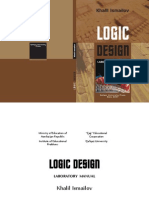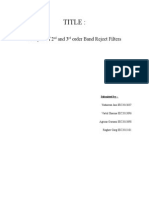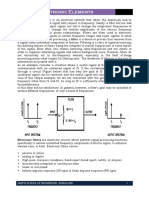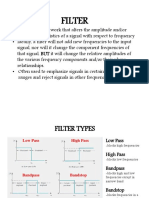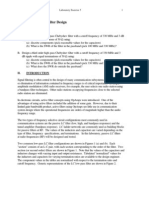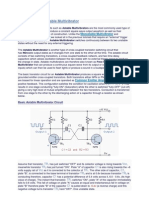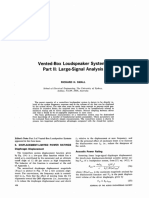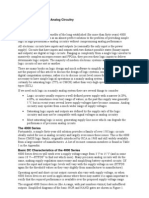Noise Power Ratio Measurement Tutorial
Noise Power Ratio Measurement Tutorial
Uploaded by
Roberto MaciasCopyright:
Available Formats
Noise Power Ratio Measurement Tutorial
Noise Power Ratio Measurement Tutorial
Uploaded by
Roberto MaciasOriginal Description:
Original Title
Copyright
Available Formats
Share this document
Did you find this document useful?
Is this content inappropriate?
Copyright:
Available Formats
Noise Power Ratio Measurement Tutorial
Noise Power Ratio Measurement Tutorial
Uploaded by
Roberto MaciasCopyright:
Available Formats
NOISE POWER RATIO MEASUREMENT TUTORIAL
By Allen Katz and Robert Gray Linearizer Technology Inc.
Introduction The performance of high power amplifiers with many carriers (>10) is normally tested using a noise power ratio (NPR) measurement technique. In this test, white noise is used to simulate the presence of many carriers of random amplitude and phase. The white noise is first passed through a bandpass filter (BPF) to produce an approximately square spectral pedestal of noise of about the same bandwidth as the signals being simulated. This signal is then passed through a narrow band-reject filter to produce a deep notch (typ. >50dB) at the center of the noise pedestal as shown in Figure 1.
Noise Pedestal
Noise
BPF
Notch
Notch
Figure 1. An NPR test generator consists of a white noise source connected in cascade with a bandpass filter and a notch filter. The notch depth can be measured with a Spectrum Analyzer. This noise signal is used to excite the test amplifier. Amplification will produce IMD products, which tend to fill in the notch. The depth of the notch at the output of the amplifier can be observed with a spectrum analyzer, and is the measure of the NPR. NPR can be considered a measure of multi-carrier intermodulation ratio (C/I). NPR differs from multi-carrier C/I in that it is the ratio of carrier plus intermodulation to intermodulation (C+I/I). At higher ratios (C/I > 20 dB), the two measures will approach the same value.
Test Hardware Considerations The bandwidth of the noise source should be much wider the bandwidth of the BPF to insure the statistical distribution of the noise power resembles a random phase multicarrier source. The width of the noise pedestal is usually made equal to bandwidth of the channel under test. In theory the NPR measured should be independent of the noise pedestals bandwidth. In practice so called amplifier memory effects may cause NPR
to degrade over wider bandwidths. The width of the notch should be about 1 percent or less of the width of the noise pedestal. A picture of an actual NPR noise pedestal and notch details as viewed on a spectrum analyzer is shown in Figure 2.
Notch Location
Notch Depth >45 dB
Figure 2. Actual NPR test signal as viewed on a spectrum analyzer NPR test signals are usually generated at IF and upconverted to the microwave band of interest. Care must be taken to insure this process does not degrade the notch depth. In wideband NPR testing, the noise figure of the amplifiers can often limit the maximum NPR measured.
T R U E N P R fo r F INITE N O T C H D E P T H
-1 0 -1 5
N O T C H = 3 0 .0 d B N O T C H = 3 5 .0 d B
T R U E N P R in dB
-2 0 -2 5 -3 0 -3 5 -4 0 -4 5 -5 0 10 15 20 25
N O T C H = 4 0 .0 d B
30
35
40
M E A S U R E D N P R in dB
Figure 3. Correction chart for true NPR for finite notch depth
A systematic error is introduced when the measured NPR is close to the depth of the testset notch. This error is most significant when the bottom of the measured notched is within 10 dB of the test-set notch depth or of the spectrum analyzers noise floor. This error can be corrected with the use of the following correction. NPR = 10 LOG(10-(NPRm/10) 10-(NPRt/10)) , where NPRm is the measured NPR and NPRt is the NPR of the test signal. This relationship is plotted in Figure 3. As NPRm approaches NPRt measurement precision will be degrading even when the correction is used. Another common source of NPR measurement error involves improper choice of the reference level for the notch depth. Notch depth should be measured relative to the average pedestal power level. When the top of the pedestal is rippled or titled, the proper reference level should be determined by averaging the changing levels across the top of the pedestal. Care should be taken to insure the pedestal level near the notch corresponds to this value. If it does not, an appropriate correction factor should be added to the observed notch depth.
Bounds on Amplifier NPR All real amplifiers have some maximum output power or saturation level. Once an amplifier has saturated, it is impossible to obtain more output power by driving the amplifier harder. Maximum linearity is achieved when an amplifier maintains a constant gain (and phase) to saturation, and a constant output level beyond saturation.This response is referred to as ideal limiter.
Figure 4. An ideal limiter maintains constant gain and phase to saturation. Figure 5 shows the 2-tone C/I and NPR achievable by an ideal limiter characteristic. This linearity is the best an amplifier can produce and sets an upper bound on the
improvement linearization can produce. Note the 2-tone C/I goes to infinity for an output power backoff (OPBO) from saturation of greater than 3 dB. This result occurs because the peak-envelope-power (PEP) of a 2-tone signal is 3 dB greater than its average power. A signal backed-off by more than 3 dB never experiences clipping at saturation, and is subject to only a linear response. However to achieve this same level of performance with a larger number of carriers requires a greater level of OPBO. This is a consequence of the increase in peak-envelope-power (PEP) with carrier number: PEP = NPav where N is the number of carriers and Pav is the average power of the overall signal. For 4 carriers the OPBO for no IMD, increases to 6 dB.
Figure 5. C/I of an ideal limiter for 2 and an infinite number of carriers (NPR).
Measured NPR of Amplifiers The NPRs of a typical TWTA and a linearized TWTA are shown in Figure 6. For an NPR ratio of 25 dB, the addition of a linearizer provides more than a 4 dB increase in amplifier power. This value is greater than the corresponding increase in power for a 2-carrier test at the same C/I ratio. In general the greater the number of carriers, the greater is the output power advantage of linearization for a given C/I ratio. In Figure 5 similar NPR measurements are shown for a class AB SSPA. At an NPR of 25 dB approximately the same improvement in output power is achieved by linearization.
35 30 NPR in dB 25 20 15 10 5 1 2 3 4 5 6 7 8 9 10 11 OPBO in dB
Figure 6. NPR predicts the improvement provided by linearization of a TWTA with many carriers.
35
NPR 30 in dB
25 20 15 10 1 2 3 4 5 6 7 OPBO in dB 8 9 10 11
Figure 7. NPR of class AB SSPA.
Summary NPR is a convenient method for evaluating the linear performance of amplifiers when operated with many carriers. Care must be taken in selecting the proper NPR test set. When measured properly NPR provides an accurate and repeatable measure of amplifier performance.
You might also like
- ARDUINO UNO DocumentDocument25 pagesARDUINO UNO DocumentAilapaka ManojNo ratings yet
- Project Report On Notch Filters: Submitted To: Submitted byDocument15 pagesProject Report On Notch Filters: Submitted To: Submitted byIrfananjum0No ratings yet
- Xelil Muellim Design - BookDocument161 pagesXelil Muellim Design - BookDyan FayeNo ratings yet
- 2nd Order, 3rd Order FiltersDocument9 pages2nd Order, 3rd Order FiltersYashaswa JainNo ratings yet
- FiltersDocument10 pagesFiltersparikshitborana99paNo ratings yet
- Band-Stop Filters: Filter, Passes All Frequencies With The Exception of Those Within ADocument3 pagesBand-Stop Filters: Filter, Passes All Frequencies With The Exception of Those Within AKrishna AgarwalNo ratings yet
- Matching 50Ω to 75Ω: Minimum-Loss PadDocument6 pagesMatching 50Ω to 75Ω: Minimum-Loss Padvaldesc_tolNo ratings yet
- High-Speed Notch Filters - Texas InstrumentsDocument8 pagesHigh-Speed Notch Filters - Texas InstrumentsmicaNo ratings yet
- 2009 IISc Filter Design Report PDFDocument258 pages2009 IISc Filter Design Report PDFKumar MadhuNo ratings yet
- Chebyshev LC Filter DesignDocument6 pagesChebyshev LC Filter Designsohagiut100% (3)
- A VCVS Notch or Band-Reject Active FilterDocument5 pagesA VCVS Notch or Band-Reject Active FilterAndrewNo ratings yet
- Baluns For Microwave Applications PDFDocument19 pagesBaluns For Microwave Applications PDFAgus SantosaNo ratings yet
- Chapter 2 RF Microwave FiltersDocument118 pagesChapter 2 RF Microwave FiltersbadhanalmominulhaqueNo ratings yet
- Bandstop FilterDocument6 pagesBandstop FilterEugene Charls GamboaNo ratings yet
- Notch FilterDocument2 pagesNotch Filterlmorales74No ratings yet
- ESP32Document49 pagesESP32GukeshNo ratings yet
- Activating and Troubleshooting The HFC Return PathDocument96 pagesActivating and Troubleshooting The HFC Return PathKot FareNo ratings yet
- Guidelines For RF PCB Design and Microwave Materials OptionsDocument15 pagesGuidelines For RF PCB Design and Microwave Materials OptionsjackNo ratings yet
- Arduino Timer and InterrupDocument10 pagesArduino Timer and InterrupFabian Monteleone100% (1)
- Filters NotesDocument20 pagesFilters NotesKart HikNo ratings yet
- Emg FiltersDocument48 pagesEmg FiltersTeheranNo ratings yet
- Arduino LCD 2Document8 pagesArduino LCD 2manoj madlur100% (1)
- TI TX LinesDocument10 pagesTI TX LinesSantosh Kumar PatraNo ratings yet
- Passive Low-Pass RF Filter Design: RF & Microwave Measurement Lab Report No. 2 February 2010Document10 pagesPassive Low-Pass RF Filter Design: RF & Microwave Measurement Lab Report No. 2 February 2010Sahand Noorizadeh100% (1)
- Arduino: LCD Diagrams & Code: Project 01: Hello, World!Document11 pagesArduino: LCD Diagrams & Code: Project 01: Hello, World!sfdsfdxfxfdxNo ratings yet
- Notch FilterDocument27 pagesNotch FilterRhamde PillogoNo ratings yet
- PCB Design Guidelines For EMI and EMCDocument17 pagesPCB Design Guidelines For EMI and EMCMadhav DimbleNo ratings yet
- Wein Bridge Oscillator CircuitDocument3 pagesWein Bridge Oscillator CircuitIndhu k100% (1)
- PCB Shieldin PDFDocument2 pagesPCB Shieldin PDFgonzalezpuertoNo ratings yet
- The Valve Wizard - Tremolo OscillatorDocument3 pagesThe Valve Wizard - Tremolo Oscillatormorag142No ratings yet
- FAF6 AC80 D 01Document20 pagesFAF6 AC80 D 01adnantahir012873100% (1)
- Lab6 Phase Locked LoopsDocument20 pagesLab6 Phase Locked Loopsuitce2011No ratings yet
- Class D Tutorial 2Document74 pagesClass D Tutorial 2Gerardo Mendez CamarilloNo ratings yet
- Field Programmable Gate Array Implementation of 14 Bit Sigma-Delta Analog To Digital ConverterDocument4 pagesField Programmable Gate Array Implementation of 14 Bit Sigma-Delta Analog To Digital ConverterInternational Journal of Application or Innovation in Engineering & ManagementNo ratings yet
- Minimizing RF PCB Electromagnetic Emissions: TutorialDocument4 pagesMinimizing RF PCB Electromagnetic Emissions: TutorialsundarvrpNo ratings yet
- Interfacing Seven Segment Display To 8051Document16 pagesInterfacing Seven Segment Display To 8051Virang PatelNo ratings yet
- MAX2606 FM TransmitterDocument2 pagesMAX2606 FM Transmitterdiv850100% (1)
- VSX-407RDS, - 607RDSDocument58 pagesVSX-407RDS, - 607RDSmichal_lysyNo ratings yet
- Pro Co Rat AnalysisDocument16 pagesPro Co Rat AnalysisgianmarcoNo ratings yet
- Active FiltersDocument1,041 pagesActive FilterstnaingooNo ratings yet
- Tba120 ReceiverDocument4 pagesTba120 ReceiverUruguayoGonzaNo ratings yet
- RF Filter Design5Document6 pagesRF Filter Design5Joel WreckedNo ratings yet
- 1308 - 12297 A New Class-D Stereo Audio Amplifier Using Direct Speaker Current ControlDocument3 pages1308 - 12297 A New Class-D Stereo Audio Amplifier Using Direct Speaker Current Controlrodales56No ratings yet
- Lecture 6 - 7 Power - AmplifiersDocument77 pagesLecture 6 - 7 Power - AmplifierssunilsheelavantNo ratings yet
- Using The Hitachi HD44780 With The Arduin1Document10 pagesUsing The Hitachi HD44780 With The Arduin1winkyiNo ratings yet
- Practical Microwave Filter DesignDocument5 pagesPractical Microwave Filter Designbongoloid100% (1)
- 1W STEREO KA2209 AMPLIFIER MODULE (3087v2) PDFDocument3 pages1W STEREO KA2209 AMPLIFIER MODULE (3087v2) PDFAlberto MoscosoNo ratings yet
- Analysis of Opamp Using PspiceDocument19 pagesAnalysis of Opamp Using PspiceKarThiNo ratings yet
- The Transistor Astable Multi VibratorDocument6 pagesThe Transistor Astable Multi VibratorTavleen KaurNo ratings yet
- Unit V - Active FiltersDocument14 pagesUnit V - Active Filterseshwar_worldNo ratings yet
- Armsravan 140618054148 Phpapp01Document132 pagesArmsravan 140618054148 Phpapp01smganorkarNo ratings yet
- Kit 90. 3 + 3 Watt Stereo Amplifier: ConstructionDocument3 pagesKit 90. 3 + 3 Watt Stereo Amplifier: ConstructionRiktam BasakNo ratings yet
- Vented. Box Loudspeaker Systems Part I1: Large-Signal AnalysisDocument7 pagesVented. Box Loudspeaker Systems Part I1: Large-Signal AnalysisEclys MontenegroNo ratings yet
- Baxandall Tone ControlDocument7 pagesBaxandall Tone ControlSheeNo ratings yet
- 4000 Series Logic and Analog CircuitryDocument13 pages4000 Series Logic and Analog Circuitrysage.electconNo ratings yet
- TV Remote Control Jammer CircuitDocument1 pageTV Remote Control Jammer Circuitsyed_hafeez_2No ratings yet
- Logic Gates 1Document17 pagesLogic Gates 1saurav chauhanNo ratings yet
- A Spectrum Analyser in Your Shack PDFDocument4 pagesA Spectrum Analyser in Your Shack PDFbaymanNo ratings yet
- TL431 Design Tips2 PDFDocument10 pagesTL431 Design Tips2 PDF3degreesNo ratings yet
- Spectrun Analysis 8554-8447Document24 pagesSpectrun Analysis 8554-8447symasiNo ratings yet


